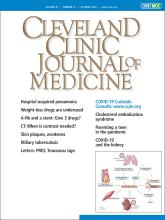To the Editor: Eponymous signs of latent tetany, tache cérébrale, and thrombosis with malignancy were ascribed to the French physician Armand Trousseau (1801–1867) in honor of his accomplishments.1 His observed sign of thrombosis in association with malignancy should be grammatically distinguished by the possessive form, “Trousseau’s sign,” since he acquired the same disease that he described in association with a gastric tumor2; “[i]t is all up with me, the appearance of a patch of phlebitis last night leaves no loophole for doubt as to the nature of my illness” (p. 836).3
Trousseau, based on clinical lectures delivered at the Hôtel-Dieu, Paris, described the association of spontaneous coagulation and phlegmasia alba dolens (painful white inflammation) in patients with thrombosis and advanced tuberculosis and uterine and visceral cancer:
“I have long been struck with the frequency with which cancerous patients are affected with painful ædema in the superior inferior extremities, whether one or other was the seat of cancer. This frequent concurrence of phlegmasia alba dolens with an appreciable cancerous tumor, led me to the inquiry whether a relationship of cause and effect did not exist between the two, and whether the phlegmasia was not the consequence of the cancerous cachexia. … I have thus been led to the conclusion, that when there is a cachectic state not attributable to the tuberculous diathesis nor to the puerperal state, there is most probably a cancerous tumor in some organ” (p. 287).4
Thus, Trousseau’s sign of malignancy refers to the presence of spontaneous, migratory, painful edema and thrombosis involving the superficial and deep veins in patients with cancer.4 “Trousseau syndrome” is an erroneous term since he never described a constellation of symptoms in this disease. A more appropriate designation is “cancer-associated thrombosis” and disease entities found in this condition, as noted by Dr. Maharaj and col-leagues.5
- Copyright © 2020 The Cleveland Clinic Foundation. All Rights Reserved.






